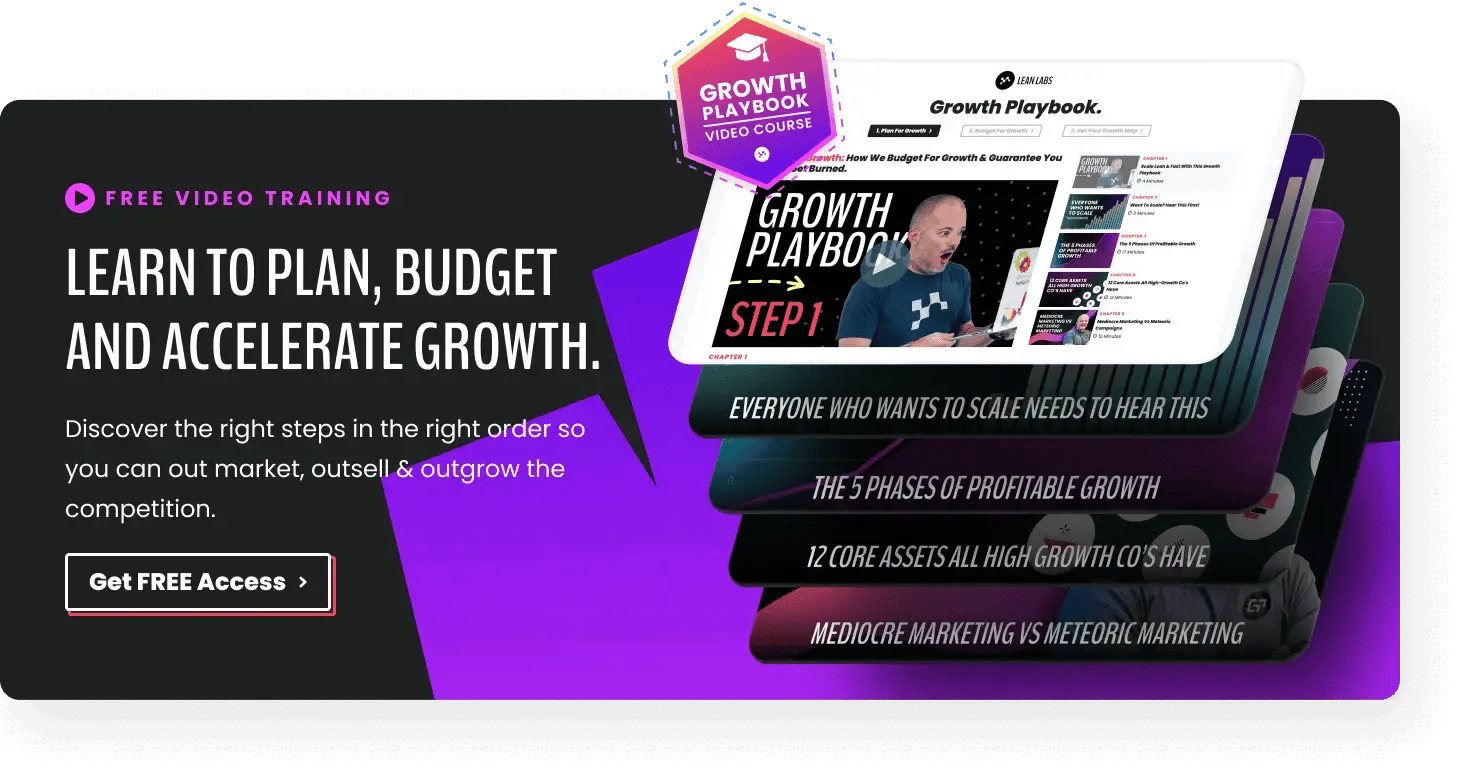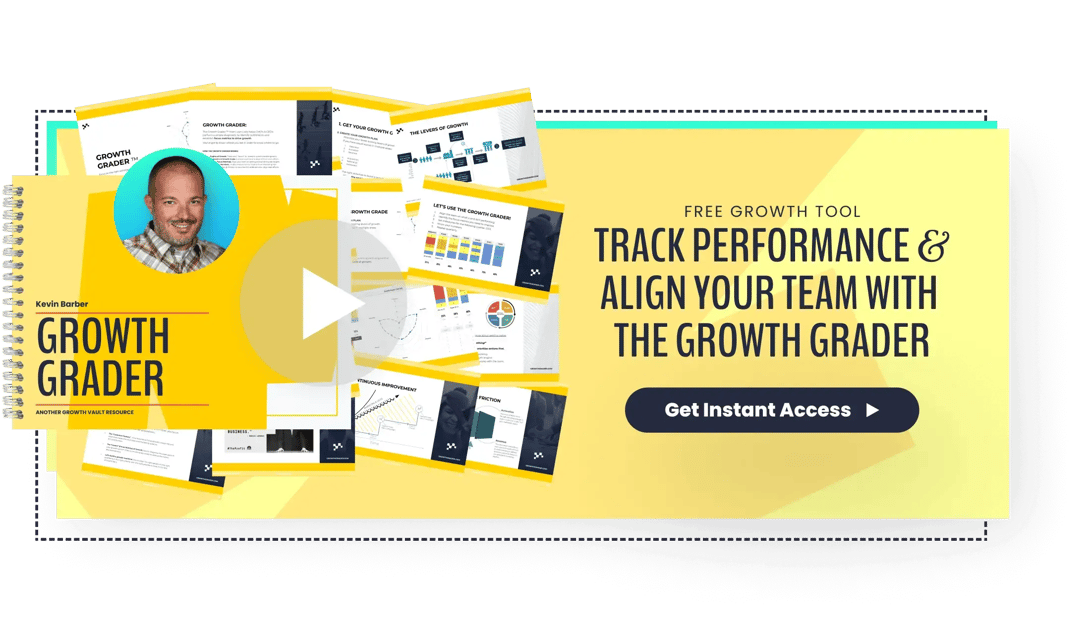What do Uber, Airbnb, Pinterest, and Google have in common? Aside from being some of the largest tech companies in the market, they have all employed the Growth Team model to aid their business’s expansion.
Is your company struggling to scale? Maybe you’ve been stuck at a plateau for years, or maybe you’re just getting off the ground and are worried that you will not be able to keep up the momentum. Regardless of what your growth challenges are, a growth team might be able to assist you. But that begs the question: What does a growth team do?
This post will give you the answer to that question. We’ll also provide you with thirteen incredible growth team plays you can leverage for your business.
VIDEO TRAINING
Get The Growth Playbook.
Learn to plan, budget, and accelerate growth with our exclusive video series. You’ll discover:
- The 5 phases of profitable growth
- 12 core assets all high-growth companies have
- Difference between mediocre marketing and meteoric campaigns
Thanks for submitting the form!
We'll review the information you've submitted and respond to you just as soon as possible.
What Does a Growth Team Do?
Let’s kick things off by answering the central question of this post: What does a growth team do? A growth team brings together professionals from across your organization to optimize every level of the customer acquisition funnel.
Collaboration is the name of the game for growth teams. Instead of working in siloes, a growth team pulls together marketing, product, sales, and success teams. For your growth team to be successful, your organization needs to embrace experimentation. Growth teams work best when they rapidly implement and test new strategies.
Growth teams utilize growth marketing strategies. This approach differs from traditional marketing in that growth marketing focuses on the entire customer acquisition funnel rather than fixating on generating traffic and leads alone. You’ll need to take customers from the moment they learn about your brand all the way to the point where they’re singing your praises from the rooftops.
With a growth marketing approach, you’ll focus on Awareness, Acquisition, and Activation to make sales… but the journey doesn’t stop there. Your growth team should also track and improve Revenue, Retention, and Referral to turn those new customers into raving fans.
1. Awareness
The first growth lever your team must focus on is awareness. As the name suggests, awareness is all about getting your brand in front of your target customers and driving traffic to your website. Many agencies will simply drive traffic to your website using paid ads, but this play isn’t necessarily the best one in the long run.
A better play here is to put aside vanity metrics and focus on attracting only the right kind of traffic. The best way to accomplish this is by finding out the challenges your ideal customers are facing and establishing how you can provide them upfront value.
Related: The Brand Awareness Strategy: 15 Marketing Tactics To Earn Attention
Website traffic, referral traffic, and social media engagement are all metrics you can use to measure your brand awareness efforts. Let’s take a look at two top plays for awareness:
Content Marketing:
Content marketing requires you to create valuable resources that your target customers will appreciate and find helpful in their journey. Content marketing builds trust with your audience by demonstrating your knowledge and setting you up as a thought leader in your industry.
To get the most from your content marketing plays, you must ensure that you optimize all your content for search engines. Without this step, you won’t be able to rank well on Google and your audience won’t be able to find your content.
Make sure you also include CTAs in your content—like this one! These calls to action guide the visitor into your pipeline.
Social Media Marketing:
B2B brands often neglect social media marketing. While it’s true that you cannot necessarily take the same approach to social media marketing as a B2C brand, you can still gain significant value from a social media marketing campaign.
Consider all the available platforms. Talk to your target customers and identify the platforms where you’re most likely to connect with them in a valuable way. LinkedIn is an excellent option for many B2B brands, but your audience may be on Twitter, YouTube, or even TikTok.
Related: This Is What A B2B Social Media Strategy Should Look Like
Use your social media efforts to connect with your followers and engage with them on a human level.
2. Acquisition
The next growth lever you must consider is acquisition. The acquisition process is where your website traffic enter your sales pipeline, officially becoming leads. The goal is to draw in the right traffic with your awareness plays, then convert that traffic into qualified leads with low-friction, high-value offers.
Conversion rates and customer acquisition costs are two metrics you may want to consider tracking related to your acquisition efforts. Two great plays for acquisition are:
Forms:
Putting a simple form on your website is a fantastic way to convert visitors into leads. Your form may be a questionnaire that offers your customers valuable insights or a newsletter subscription sign-up.
Regardless of what shape your form takes, you must use the form submission process to obtain basic contact information from your site visitors. Keep your forms as simple to complete as possible by asking for only the information you need to bring someone into your funnel.
For example, even if it is beneficial to know the annual revenue of your new lead’s company or how the lead found your website upfront, you can increase the likelihood that a visitor converts by simply asking for company name and email address.
Lead Magnets:
When you create a lead magnet, you are essentially creating a resource you hope is valuable enough to trade for a site visitor’s contact information. Take a close look at your target customers—what information would be valuable enough to convince them to roll the dice and give your brand their email?
The most effective offers are targeted resources that will help your audience solve a specific problem. Consider ebooks, video training, or templates. You can simply create a lead magnet by mining your current site for content. Examine your most popular blog posts and see if you can repurpose the information into a format worthy of converting to receive.
3. Activation
The third stage of the customer acquisition funnel is activation. In this stage, you qualify leads and convert them into paying customers. How easy (or challenging) this stage is for your brand depends heavily on the success of your awareness and activation efforts. Activation will be far simpler if you’re making the right plays upfront and bringing the right traffic to your site.
Some metrics to consider for the activation phase are activation rate and visitor-to-customer conversion rates. Three possible activation plays include:
Lead Nurturing Emails:
Lead nurturing is vital to the activation process. Use your CRM to segment your contact list and create email sequences designed to reach, provide value to, and nurture contacts at each stage of their buyers’ journey.
Related: The Best Email Marketing Software
The trick here is to provide value first rather than using email to contact leads only when you need something from them. Consider sending regular campaigns that will meet your audience where they are in their buyer journey and show them the value of taking their relationship with your brand to the next level.
Discovery Calls:
Discovery calls are a great play for connecting with prospects and establishing whether or not they are a match for your business. Approach your discovery calls with a proactive mindset. Rather than rattling off a dozen questions about your prospects’ needs and challenges, show them you already understand their pain points and connect with them on possible solutions.
Webinars:
Webinars allow your brand to interact with potential customers on a personal level while also demonstrating your knowledge and expertise. Ensure your webinars are engaging, valuable, and informative.
4. Revenue
If you’ve been in the business world long, chances are you’re pretty familiar with the concept of revenue. Concerning the customer acquisition funnel, however, revenue refers to the number of sales-qualified leads you close compared with the number still sitting in your pipeline.
Related: 7-Step Vs. 5-Step Sales Process: A Look At The Pros And Cons
Some revenue metrics you’ll want to track include sales cycle length and annual recurring revenue (AAR). Your success in the earlier stages of the pipeline will have a significant impact on the success of your revenue efforts. However, a few revenue plays are:
Sales Calls:
This play is fairly self-explanatory. Your sales team can generate revenue by making sales calls. Connecting with leads on sales calls helps guide them through the buying process on a personal level.
Pricing Models:
Another play you can try related to revenue is testing out different pricing models. If you are struggling to close deals, you may want to consider taking another look at your packages. Is there a way you can offer a lower-level package for more entry-level customers? SaaS brands may want to explore offering access to their product on a freemium model to bring new customers in the metaphorical door.
5. Retention
What’s your churn rate look like? If you’re losing more customers than you’re bringing in, your business isn’t growing. Retention is all about delighting your customers so they stick around after they’ve made their initial purchase decision.
Retention is all about a customer’s lifetime value (LTV). You can calculate LTV using the below formula:
LTV = Customer Value X Average Customer Lifespan
Here are some plays to consider for retention:
Continuous Value:
Think about the brands you buy from time and time again—you probably have a solid reason why. Maybe their customer support always answers the phone without putting you through an hour-long hold loop. Perhaps they are always innovating and coming out with new tools that make your life easier.
Focus on providing continuous support and value to your customers. By approaching your customer relationships in a human and helpful way, you’ll be able to keep them coming back time and time again.
Value Ladder:
In The Invisible Selling Machine, Ryan Deiss establishes an important truth: Of the people who purchase a solution from your business, there is always a percentage who would buy more if offered.
If offered is the operative portion of this sentence.
Keep customers engaged with your brand by offering current customers targeted resources and solutions that will provide them additional value. Many will ignore your offer… but at least a few will likely take you up on it.
6. Referrals
If you’re considering making an expensive purchase, what is one of the first things you do? Check customer reviews. Your potential customers are likely doing the same thing. This tendency is why the sixth growth lever is vital to your success.
Happy customers become raving fans. These raving fans will not only stick around and buy from you again—they’ll tell everyone and their brother about how amazing your brand is. These referrals build credibility for your brand and help potential customers put themselves in the shoes of your current customers to see how they can succeed with your help.
Related: 5 Ways To Incorporate Customer Stories In Your Content
How can you build a referral engine? Use these plays:
Ask for Testimonials:
The best way to get testimonials and reviews? Ask for them. Time your requests well and phrase them similar to this:
“If you feel like you’ve gotten value from our interaction, I’d be honored if you’d give us a five-star review.”
You can also ask customers to engage in case studies or testimonials. If you’re delighting your customers, chances are they’ll be happy to take a few minutes out of their day to talk about why they love you.
Offer Referral Benefits:
Another option for the referral stage of the funnel is to offer your customers benefits for referring a friend. You can offer a free resource, a discount, or even a gift card to any customer who refers a lead to your business.
What Does a Growth Team Do — And How Can You Maximize Results?
Armed with the information in this post, you should see that a growth team works by leveraging every single step in the customer acquisition funnel. Adopting the plays listed in this post can give your growth team the tools they need to help your brand succeed.
The next question you need to ask yourself is whether you want to partner with an outsourced growth team or hire an in-house team. Lean Labs has nearly a decade of experience working with brands and helping them 10x their growth. To learn how we do what we do, check out our free resource, the Growth Playbook, today!








